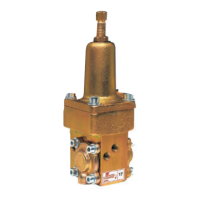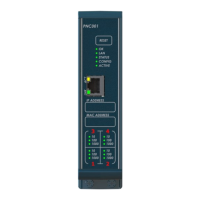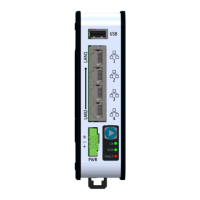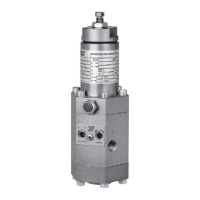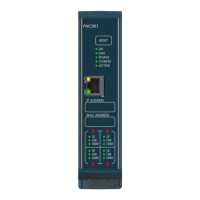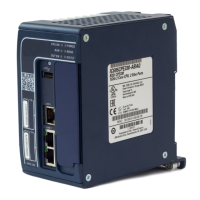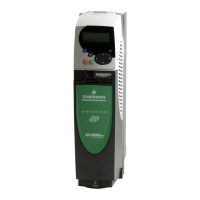Safety
information
Product
information
Mechanical
installation
Electrical
installation
Getting
started
Basic
parameters
Running
the motor
Optimization
NV Media Card
Operation
Onboard
PLC
Advanced
parameters
Technical
data
Diagnostics
UL listing
information
130 Powerdrive F300 User Guide
Issue Number: 2
6.3.12 Advanced process PID
The Advanced Process PID comprises two PID controllers. PID 1 can be
configured to operate as follows (refer to Pr 14.059 for details).
• Single setpoint and single feedback
• Single setpoint and dual feedback
• Dual setpoints and dual feedback
PID 2 always operates as a single setpoint, single feedback controller.
When a feedback signal requires square root conversion (e.g. airflow),
square root scaling can be applied to PID 1 feedback (see Pr 14.058,
Pr 14.060, Pr 14.061 and Pr 14.062). PID 1 also includes a pre-sleep
boost level facility (see Pr 14.028 and Pr 14.029) to reduce frequent
transitions into sleep mode when the PID is used.
The PID system is always active even when the output destination
parameters are not set to a valid destination parameter. This allows the
PID controllers to be used independently from the drive via a building
automation network.
Pr 14.001 is the output (limited by Pr 14.013 and Pr 14.014) from PID 1
before scaling (Pr 14.015) is applied. It is derived from the following
algorithm:
Output = Error x [Kp + Ki/s + Kds/(0.064s + 1)]
Where:
Error = Reference (Pr 14.003, Pr 14.025) - Feedback
(Pr 14.004)
Kp = proportional gain (Pr 14.010)
Ki = integral gain (Pr 14.011)
Kd = differential gain (Pr 14.012)
Therefore with an error of 100% and Kp = 1.000, the output produced by
the proportional term is 100%. With an error of 100% and Ki = 1.000 the
output produced by the integral term will increase linearly by 100% every
second. With an error that is increasing by 100% per second and Kd =
1.000 the output produced by the differential term will be 100%. A filter
with a 64 ms time constant is applied to the differential term to reduce
noise.
The PID reference is the sum of the digital reference (Pr 14.025) and the
value from the location defined by the source parameter (Pr 14.003).
Before the reference is applied to the controller algorithm, it can be
scaled by setting Pr 14.023 to a value other than one and/or inverted by
setting Pr 14.005 = 1.
The feedback is the sum of the digital feedback (Pr 14.026) and the
value from the location defined by the source parameter (Pr 14.004).
Before the reference is applied to the controller algorithm, it can be
scaled by setting Pr 14.024 to a value other than one and/or inverted by
setting Pr 14.006 = 1.
Pr 14.007 defines the time taken for the reference input to ramp from 0
to 100% following a 0 to 100% step change in input.
Trip
number
String Cause of trip
2 OU DC bus over-voltage
3 OI.AC AC instantaneous over-current
4 OI.br
Braking resistor instantaneous over
current
5 PS Drive power supply fault
8 PS.10V 10V user power supply overload
9 PS.24V 24V internal power supply overload
21 O.ht1
Power device over temperature based
on thermal model
31 EEF EEProm failure
36 SAVE.Er User parameter save error
37 PSAVE.Er Power down save parameter error
103 OIbr.P
Power module braking IGBT over
current
104 OIAC.P
Power module over current detected
from the module output currents
105 Oht2.P
Power module heatsink over
temperature
106 OU.P Power module DC bus over-voltage
107 Ph.P Power module phase loss detection
108 PS.P Power module power supply fail
109 OIdc.P
Power module over current detected
from on state voltage monitoring
110 Unid.P Power module unidentified trip
200 SL1.HF Slot 1 Option Module failure
205 SL2.HF Slot 2 Option Module failure
210 SL3.HF Slot 3 Option Module failure
217 to 232 HF17 to HF32 Hardware faults
It is possible for the drive or motor to become damaged when
operating in fire mode because some of the drive thermal
protection trips are disabled.
14.001 PID 1 output
14.031 PID 2 output
RO Bi NC PT
Ú
±100.00
Ö
14.002 PID main reference source parameter
RW Uni PT US
Ú
Pr 0.000 to Pr 50.099
Ö
Pr 0.000
14.003 PID 1 reference source parameter
14.033 PID 2 reference source parameter
RW Uni PT US
Ú
Pr 0.000 to Pr 50.099
Ö
Pr 0.000
14.004 PID 1 feedback source parameter
14.034 PID 2 feedback source parameter
RW Uni PT US
Ú
Pr 0.000 to Pr 50.099
Ö
Pr 0.000
14.005 PID 1 reference invert
14.035 PID 2 reference invert
RW Bit US
Ú
OFF (0) or On (1)
Ö
OFF (0)
14.006 PID 1 feedback invert
14.036 PID 2 feedback invert
RW Bit US
Ú
OFF (0) or On (1)
Ö
OFF (0)
14.007 PID 1 reference slew-rate limit
14.037 PID 2 reference slew-rate limit
RW Uni US
Ú
0.0 to 3200.0 s
Ö
0.0
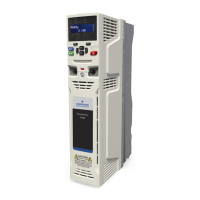
